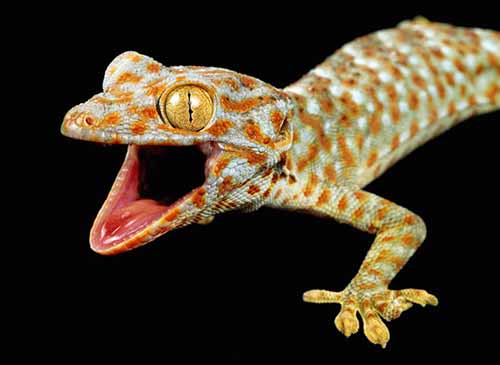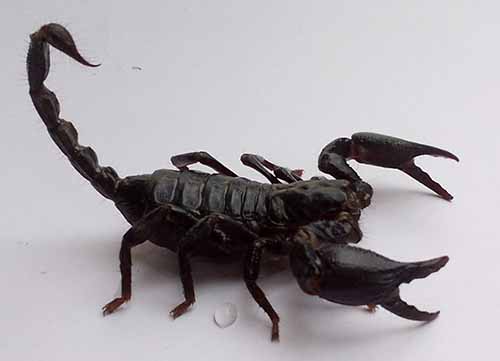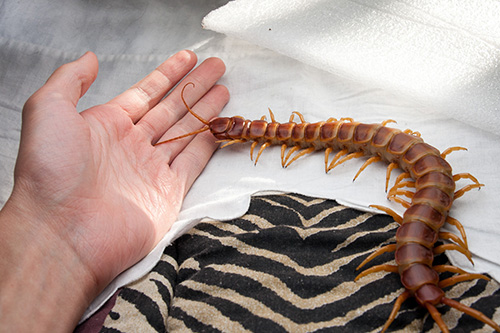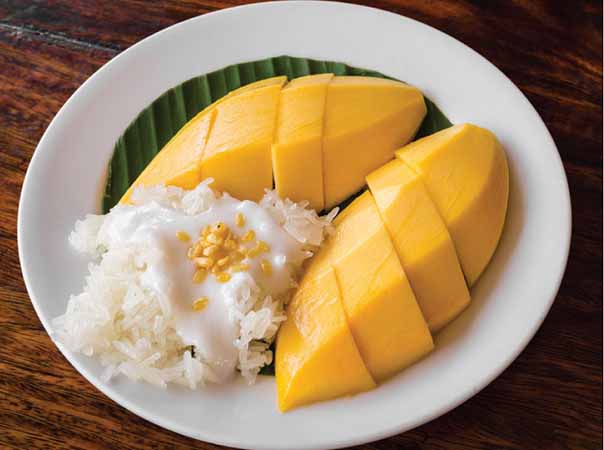Living with (and on) Thailand’s Creepy Crawlies
Originally posted on November 1, 2011
One thing a person from a colder climate discovers when they move to the tropics is that much more stuff here seems to be alive. Touch a tree and your hand comes away covered in ants, some biting like crazy. Smell a flower and you stir up bees, wasps, butterflies and moths. Walk through the grass and insects, frogs, birds, and snakes (hopefully) jump out of your way. The tropics is like a great big, living soup.
I’ve had cobras, lizards, turtles, giant snails, huge rodents, bofo toads, and lightening fast monitor lizards in my garden. Scoop up some pond or stream water and it is teeming with insect larvae, small fish, tadpoles of a dozen varieties, and who knows how many parasites. The nights are a cacophony of living noises. And in the mornings the bird songs and rooster crows will make “sleeping in” impossible.
Termites are our current nemesis. Any wood in your house, your furniture even a simple door frame, is fair game. If tomorrow all the people in the world disappear it won’t be the lion that will be the king of the world. It will be the termites.
There are over 800 species of birds and another 800 species of butterflies living in Thailand alone. I once identified 50 species of birds in one morning while sitting on my front porch when I was living in Samutprakarn. That same garden was the inspiration for one of my first articles for the Bangkok Post, “Cobras in My Garden”.
It is inevitable that all these creepy crawlies will become part of your everyday life.
One thing they often become is food. There is a saying here that if it moves and has legs and it isn’t a piece of furniture, then you can eat it. In some parts of Thailand insects, something Westerners usually don’t consider edible, are an everyday part of the diet. There are lots of YouTube videos and pictures on the Internet of people (Westerners) eating crickets, grasshoppers, scorpions, and other 6 and 8 legged creatures in Thailand as if this were the height of bravery. Check this out to see some examples of brave souls. When the Thais see this they just seem to think that we are being a bit quaint in the excitement we get by putting something this strange into our mouths. For them it is normal stuff.
I have to admit though that it took a bit for me to learn to consider insects as food. Here is what happened.
The curator at the reptile department at the Chiang Mai Zoo, a person who helps us with our endangered tortoise sanctuary (mentioned before on these pages), told us that he was having trouble getting really small crickets for his tiny South American poison arrow frogs to eat. So we said we would look into seeing if we could raise some ourselves. We asked the lady selling crickets at the local market if she could help with some advice. She gladly agreed since we weren’t going to be her competition. In fact she said that her crickets were so popular that she always sold out and usually never had any left, but today (lucky for me) she had a few extra.
So she offered us some of these crispy delights to taste for free. I try to be as polite as I can in cross cultural situations so I couldn’t turn her down but I didn’t let my face show the expression that my mind was thinking. The cricket was deep fried and fat. She chose the fattest ones for us, the ones with eggs since they are tastier. I popped one in my mouth and, interesting, it didn’t taste bad. I didn’t like the crunchy parts so the next one I pulled off the head and feet and tried again. It was sort of like a rich tasting potatoe chip or a flavorful pork rind. So those videos showing all those tourists saying “Not bad” after braving that first taste, that was the same thing I was thinking.
I just heard this on National Public Radio (NPR):
“Nate Erwin, manager of the Insect Zoo at the Smithsonian’s Museum of Natural History, says grasshoppers are 60 percent protein and about 6 percent fat, while beef is about 18 percent protein and 18 percent fat. For 100 pounds of grain feed, he says, you’ll get 10 pounds of beef, but 45 pounds of crickets. Plus, crickets are high in calcium.”
So if you are a “green” thinking person you might want to consider a change in diet. Here to help you is a page from a Thai cooking website – “Snacking on Deep Fried Bugs in Thailand”.
You may never develop the habit of ingesting our insect friends. But Nature and its children will soon become an intimate part of your life here in Thailand in many other ways.
The following is taken from a chapter in my eBook Retired Life in Thailand (free for download here in the eBooks section).
Uninvited Houseguests
If you have gotten to the point of setting up house here in Thailand then you have probably already experienced some uninvited houseguests. No, we are not talking about your cousin Bubba dropping in unexpectedly. The houseguests we are referring to are the creepy crawlies that invade our homes here.
Some while ago a medical lab technician came to work in a hospital here from the US. A few of us helped move her in to a nice dormitory room on the hospital campus and, as it was late, we told her we would be by early the next day to check on her.
As we entered her room the next morning we noticed a peculiar sight. Her walls were covered with red splotches. “What happened”, I asked. “I was invaded in here last night,” she said, “there were dozens of these lizard things crawling all over the walls. It was horrible. But don’t worry, I got rid of them with my shoe.”
I guess she’d never seen a house gecko before. “ching chok“, as they are called in Thai, are the common reptile mosquito control agents that live in all Thai houses. Please don’t kill them. They are good guys, except for the tiny droppings that fall into our noodles as they scamper across the ceiling or the occasional egg laid in your shoe.
A relative of the house gecko, the tokay gecko, is about as long as your forearm, green with red or yellow spots. Late at night you may be shocked out of bed by a loud “tokay, tokay” repeated many times over. Although they look like something out of Jurassic Park they also are good guys. They help deal with some other really nasty critters. Like flying roaches.
When I lived in a wooden house, every night, in the few seconds from the time I turned the light off, to before getting under the mosquito net, I would be attacked by flying roaches. They probably had been waiting all day for this opportunity. These guys are about 3 inches long, and they fly. They would fly in the dark straight for my head and get tangled in my hair. I live in a concrete house now and don’t have that problem.
Centipedes sometimes get in the house. For most westerners a centipede is no big thing. Well, they certainly are “big things” here. They can get as long as eight inches and they have a bite that can put you in the hospital.
Flying termites will swarm during the early rainy season nights. There are 20,000 species of ants in the world, 3,000 live in bamboo alone. I think there are at least as many as that living in and around my house. You’ll get used to the bites of red weaver ants. Their nests in the mango trees are filled with their white larva, a gourmet delicacy. Then there are the tiny itchy fire ants whose bites once almost put me into shock. And of course there are the ants that seem to love living in my toothbrush.
Forget about trying to kill them all or even trying to keep them out of your house. That’s a lost cause. Just keep your house clean and don’t leave any left over food out. If all goes well, you’ll soon learn to live in harmony with all of god’s creatures; like huge hairy spiders and 6 inch black scorpions. You’ll know you have really adapted to life here when even that occasional cobra in your garden won’t bother you.











